Microeconomics Assignment: Elasticity, Revenue, and Demand Analysis
VerifiedAdded on 2022/08/13
|8
|703
|14
Homework Assignment
AI Summary
This microeconomics assignment solution covers key concepts of elasticity, including price elasticity of demand, cross-price elasticity, and income elasticity of demand. It analyzes how changes in price and income affect demand for various goods, such as boxes and bus rides, and their impact on total revenue. The assignment includes calculations and explanations for inelastic and elastic demand scenarios, demonstrating the relationship between price changes and revenue. The solution also explores the concepts of substitute goods and inferior goods within the context of demand analysis, providing a comprehensive understanding of microeconomic principles. The assignment is a valuable resource for students studying microeconomics and preparing for exams.
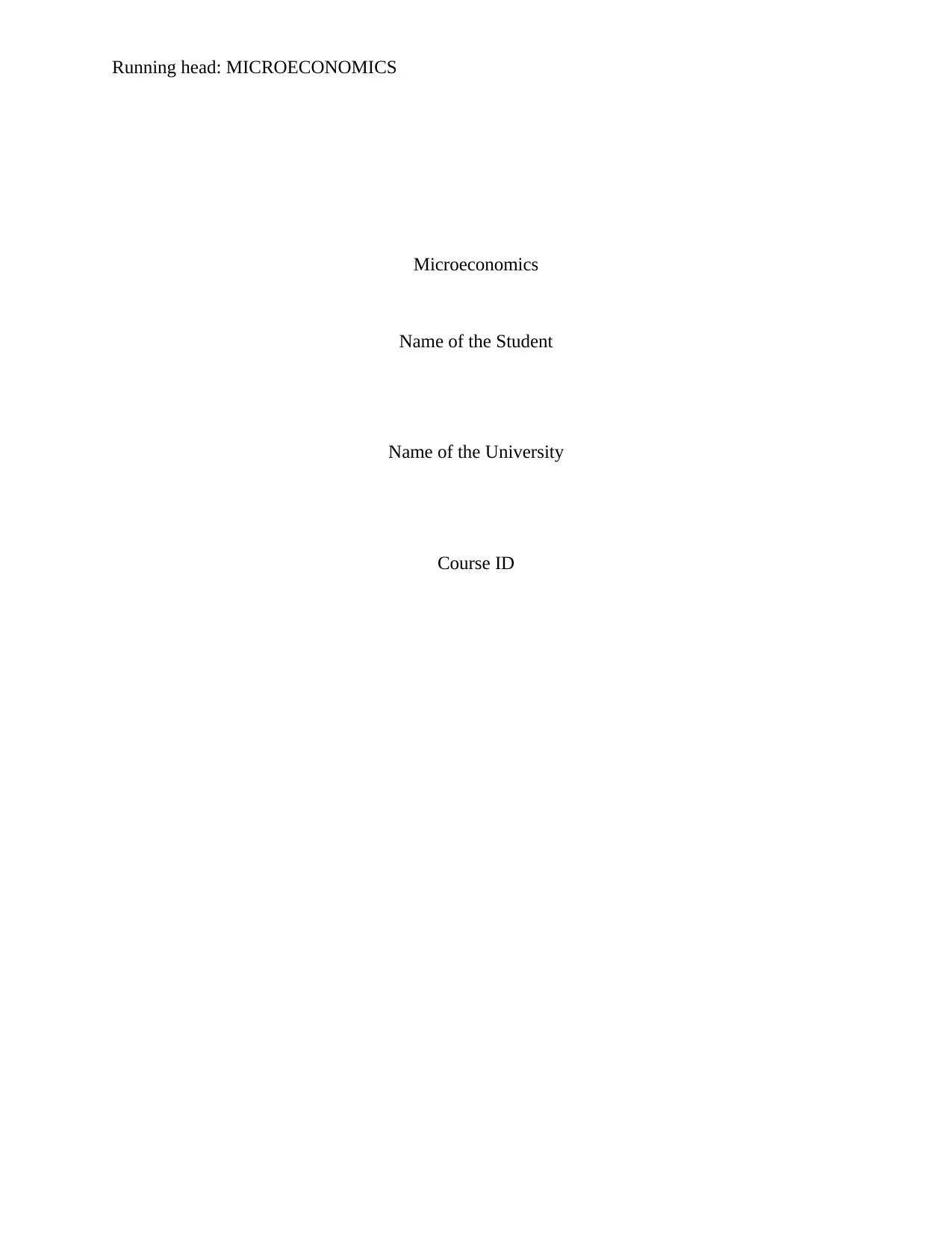
Running head: MICROECONOMICS
Microeconomics
Name of the Student
Name of the University
Course ID
Microeconomics
Name of the Student
Name of the University
Course ID
Paraphrase This Document
Need a fresh take? Get an instant paraphrase of this document with our AI Paraphraser
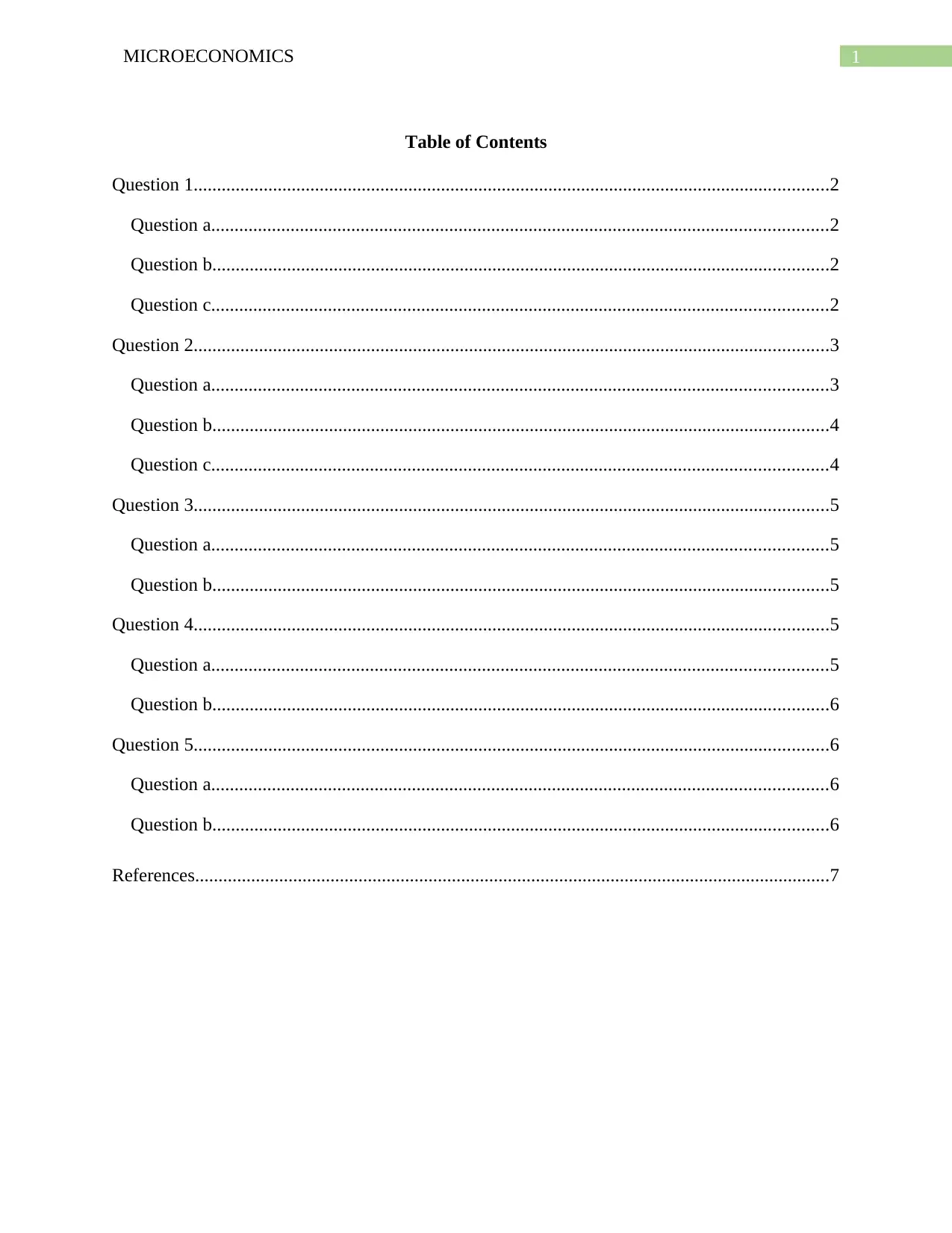
1MICROECONOMICS
Table of Contents
Question 1........................................................................................................................................2
Question a....................................................................................................................................2
Question b....................................................................................................................................2
Question c....................................................................................................................................2
Question 2........................................................................................................................................3
Question a....................................................................................................................................3
Question b....................................................................................................................................4
Question c....................................................................................................................................4
Question 3........................................................................................................................................5
Question a....................................................................................................................................5
Question b....................................................................................................................................5
Question 4........................................................................................................................................5
Question a....................................................................................................................................5
Question b....................................................................................................................................6
Question 5........................................................................................................................................6
Question a....................................................................................................................................6
Question b....................................................................................................................................6
References........................................................................................................................................7
Table of Contents
Question 1........................................................................................................................................2
Question a....................................................................................................................................2
Question b....................................................................................................................................2
Question c....................................................................................................................................2
Question 2........................................................................................................................................3
Question a....................................................................................................................................3
Question b....................................................................................................................................4
Question c....................................................................................................................................4
Question 3........................................................................................................................................5
Question a....................................................................................................................................5
Question b....................................................................................................................................5
Question 4........................................................................................................................................5
Question a....................................................................................................................................5
Question b....................................................................................................................................6
Question 5........................................................................................................................................6
Question a....................................................................................................................................6
Question b....................................................................................................................................6
References........................................................................................................................................7
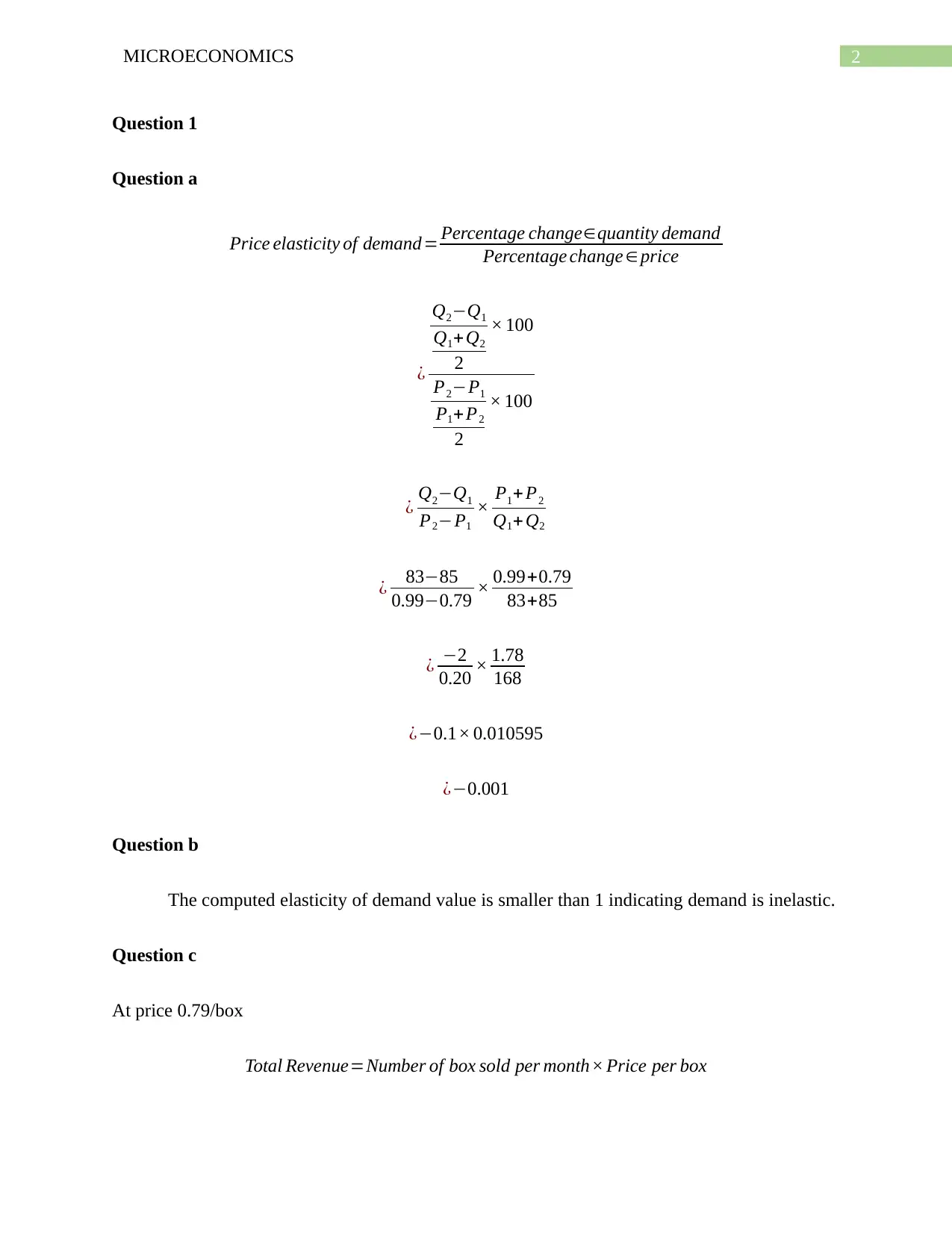
2MICROECONOMICS
Question 1
Question a
Price elasticity of demand= Percentage change∈quantity demand
Percentage change ∈ price
¿
Q2−Q1
Q1+ Q2
2
× 100
P2−P1
P1+ P2
2
× 100
¿ Q2−Q1
P2−P1
× P1+ P2
Q1+ Q2
¿ 83−85
0.99−0.79 × 0.99+0.79
83+85
¿ −2
0.20 × 1.78
168
¿−0.1× 0.010595
¿−0.001
Question b
The computed elasticity of demand value is smaller than 1 indicating demand is inelastic.
Question c
At price 0.79/box
Total Revenue=Number of box sold per month× Price per box
Question 1
Question a
Price elasticity of demand= Percentage change∈quantity demand
Percentage change ∈ price
¿
Q2−Q1
Q1+ Q2
2
× 100
P2−P1
P1+ P2
2
× 100
¿ Q2−Q1
P2−P1
× P1+ P2
Q1+ Q2
¿ 83−85
0.99−0.79 × 0.99+0.79
83+85
¿ −2
0.20 × 1.78
168
¿−0.1× 0.010595
¿−0.001
Question b
The computed elasticity of demand value is smaller than 1 indicating demand is inelastic.
Question c
At price 0.79/box
Total Revenue=Number of box sold per month× Price per box
⊘ This is a preview!⊘
Do you want full access?
Subscribe today to unlock all pages.

Trusted by 1+ million students worldwide
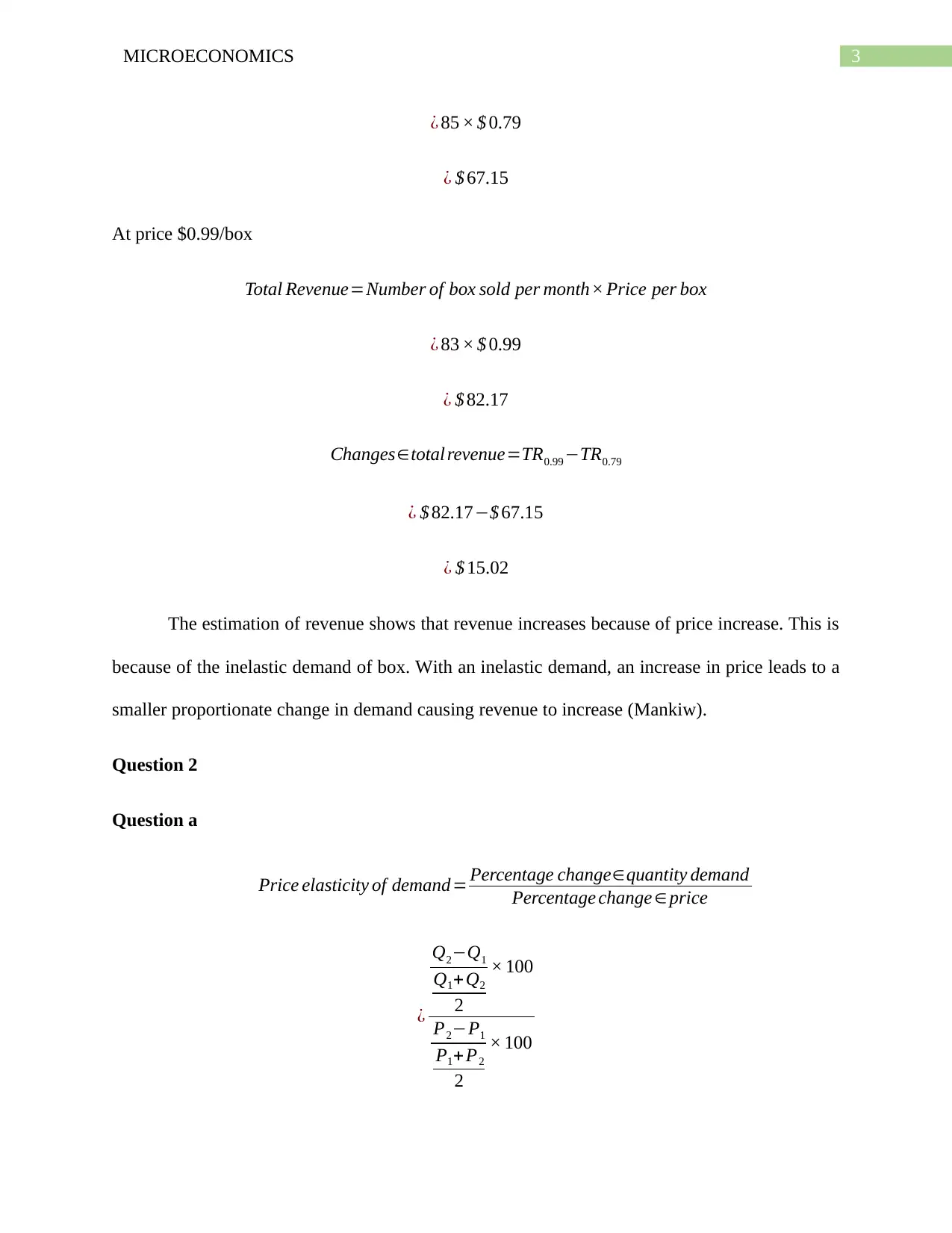
3MICROECONOMICS
¿ 85 × $ 0.79
¿ $ 67.15
At price $0.99/box
Total Revenue=Number of box sold per month× Price per box
¿ 83 × $ 0.99
¿ $ 82.17
Changes∈total revenue=TR0.99 −TR0.79
¿ $ 82.17−$ 67.15
¿ $ 15.02
The estimation of revenue shows that revenue increases because of price increase. This is
because of the inelastic demand of box. With an inelastic demand, an increase in price leads to a
smaller proportionate change in demand causing revenue to increase (Mankiw).
Question 2
Question a
Price elasticity of demand= Percentage change∈quantity demand
Percentage change ∈ price
¿
Q2−Q1
Q1+ Q2
2
× 100
P2−P1
P1+ P2
2
× 100
¿ 85 × $ 0.79
¿ $ 67.15
At price $0.99/box
Total Revenue=Number of box sold per month× Price per box
¿ 83 × $ 0.99
¿ $ 82.17
Changes∈total revenue=TR0.99 −TR0.79
¿ $ 82.17−$ 67.15
¿ $ 15.02
The estimation of revenue shows that revenue increases because of price increase. This is
because of the inelastic demand of box. With an inelastic demand, an increase in price leads to a
smaller proportionate change in demand causing revenue to increase (Mankiw).
Question 2
Question a
Price elasticity of demand= Percentage change∈quantity demand
Percentage change ∈ price
¿
Q2−Q1
Q1+ Q2
2
× 100
P2−P1
P1+ P2
2
× 100
Paraphrase This Document
Need a fresh take? Get an instant paraphrase of this document with our AI Paraphraser
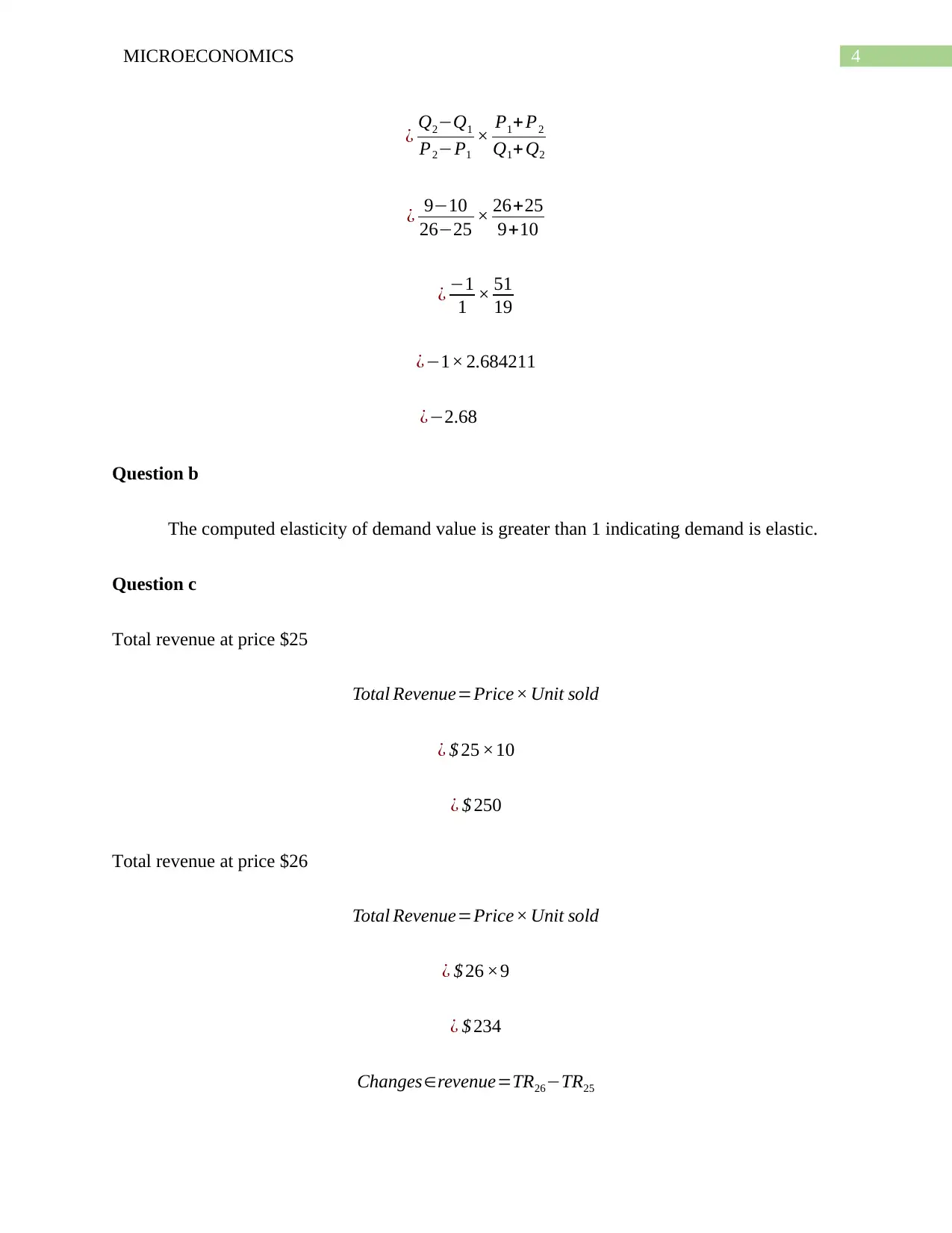
4MICROECONOMICS
¿ Q2−Q1
P2−P1
× P1+P2
Q1+Q2
¿ 9−10
26−25 × 26+25
9+10
¿ −1
1 × 51
19
¿−1× 2.684211
¿−2.68
Question b
The computed elasticity of demand value is greater than 1 indicating demand is elastic.
Question c
Total revenue at price $25
Total Revenue=Price× Unit sold
¿ $ 25 ×10
¿ $ 250
Total revenue at price $26
Total Revenue=Price× Unit sold
¿ $ 26 ×9
¿ $ 234
Changes∈revenue=TR26−TR25
¿ Q2−Q1
P2−P1
× P1+P2
Q1+Q2
¿ 9−10
26−25 × 26+25
9+10
¿ −1
1 × 51
19
¿−1× 2.684211
¿−2.68
Question b
The computed elasticity of demand value is greater than 1 indicating demand is elastic.
Question c
Total revenue at price $25
Total Revenue=Price× Unit sold
¿ $ 25 ×10
¿ $ 250
Total revenue at price $26
Total Revenue=Price× Unit sold
¿ $ 26 ×9
¿ $ 234
Changes∈revenue=TR26−TR25
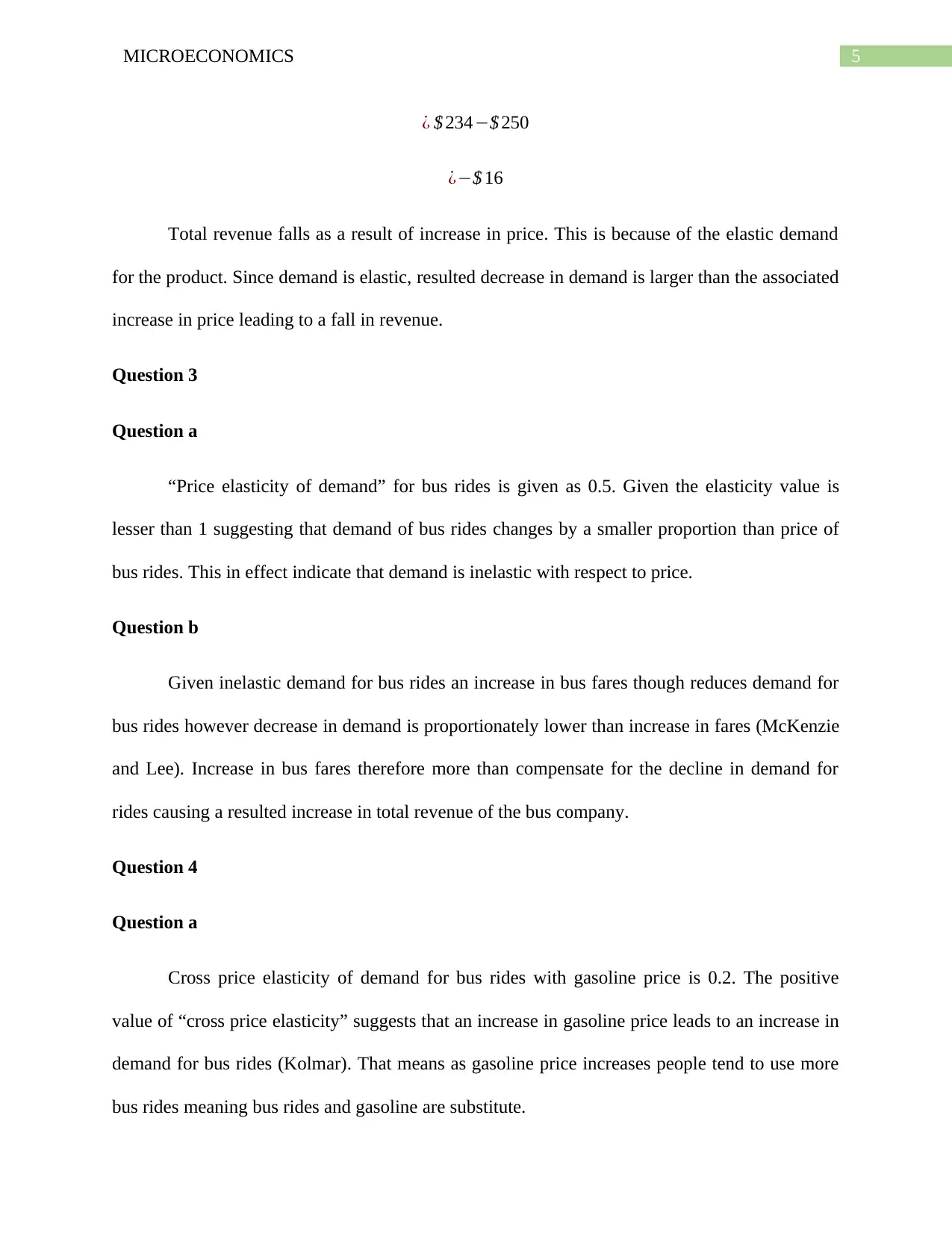
5MICROECONOMICS
¿ $ 234−$ 250
¿−$ 16
Total revenue falls as a result of increase in price. This is because of the elastic demand
for the product. Since demand is elastic, resulted decrease in demand is larger than the associated
increase in price leading to a fall in revenue.
Question 3
Question a
“Price elasticity of demand” for bus rides is given as 0.5. Given the elasticity value is
lesser than 1 suggesting that demand of bus rides changes by a smaller proportion than price of
bus rides. This in effect indicate that demand is inelastic with respect to price.
Question b
Given inelastic demand for bus rides an increase in bus fares though reduces demand for
bus rides however decrease in demand is proportionately lower than increase in fares (McKenzie
and Lee). Increase in bus fares therefore more than compensate for the decline in demand for
rides causing a resulted increase in total revenue of the bus company.
Question 4
Question a
Cross price elasticity of demand for bus rides with gasoline price is 0.2. The positive
value of “cross price elasticity” suggests that an increase in gasoline price leads to an increase in
demand for bus rides (Kolmar). That means as gasoline price increases people tend to use more
bus rides meaning bus rides and gasoline are substitute.
¿ $ 234−$ 250
¿−$ 16
Total revenue falls as a result of increase in price. This is because of the elastic demand
for the product. Since demand is elastic, resulted decrease in demand is larger than the associated
increase in price leading to a fall in revenue.
Question 3
Question a
“Price elasticity of demand” for bus rides is given as 0.5. Given the elasticity value is
lesser than 1 suggesting that demand of bus rides changes by a smaller proportion than price of
bus rides. This in effect indicate that demand is inelastic with respect to price.
Question b
Given inelastic demand for bus rides an increase in bus fares though reduces demand for
bus rides however decrease in demand is proportionately lower than increase in fares (McKenzie
and Lee). Increase in bus fares therefore more than compensate for the decline in demand for
rides causing a resulted increase in total revenue of the bus company.
Question 4
Question a
Cross price elasticity of demand for bus rides with gasoline price is 0.2. The positive
value of “cross price elasticity” suggests that an increase in gasoline price leads to an increase in
demand for bus rides (Kolmar). That means as gasoline price increases people tend to use more
bus rides meaning bus rides and gasoline are substitute.
⊘ This is a preview!⊘
Do you want full access?
Subscribe today to unlock all pages.

Trusted by 1+ million students worldwide
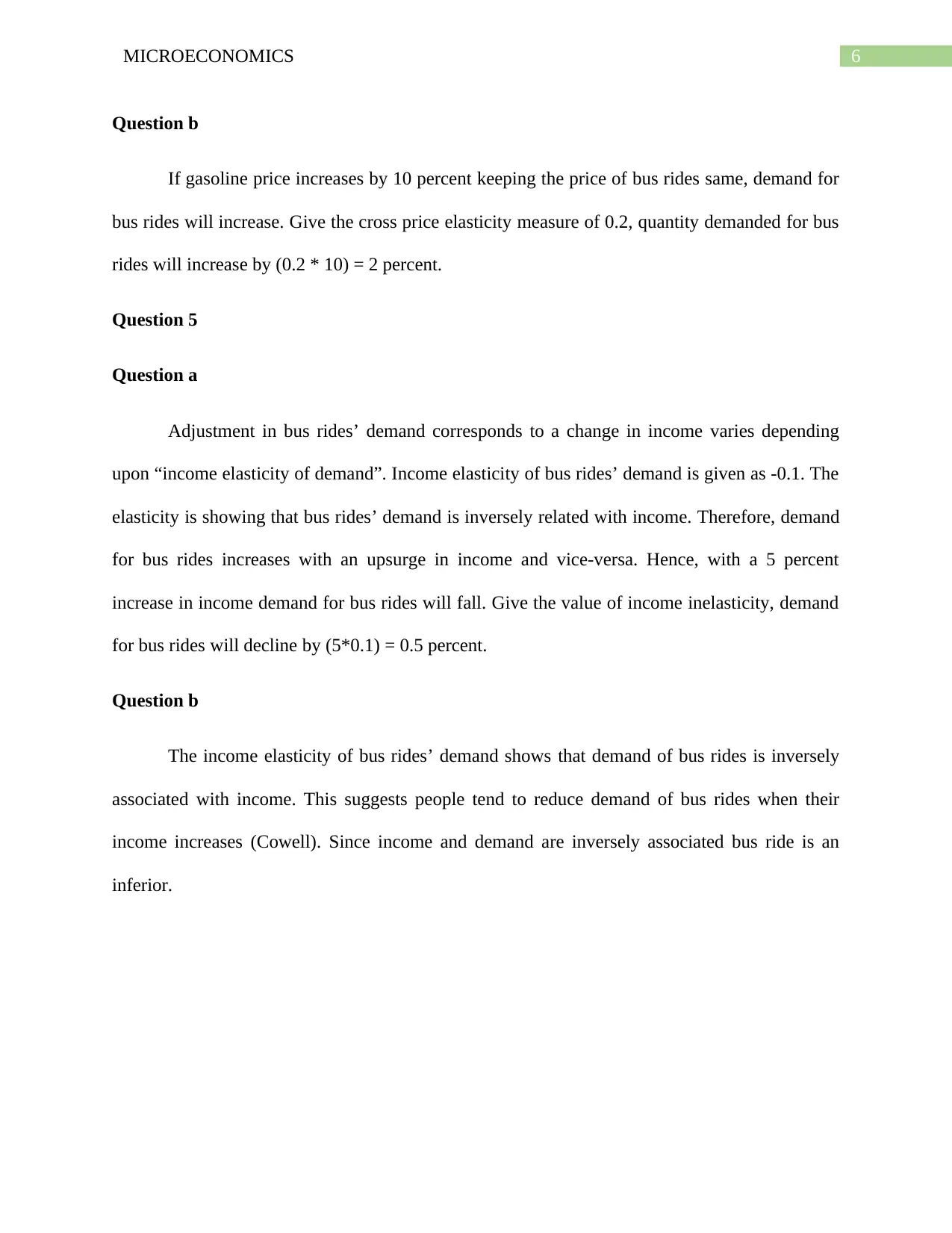
6MICROECONOMICS
Question b
If gasoline price increases by 10 percent keeping the price of bus rides same, demand for
bus rides will increase. Give the cross price elasticity measure of 0.2, quantity demanded for bus
rides will increase by (0.2 * 10) = 2 percent.
Question 5
Question a
Adjustment in bus rides’ demand corresponds to a change in income varies depending
upon “income elasticity of demand”. Income elasticity of bus rides’ demand is given as -0.1. The
elasticity is showing that bus rides’ demand is inversely related with income. Therefore, demand
for bus rides increases with an upsurge in income and vice-versa. Hence, with a 5 percent
increase in income demand for bus rides will fall. Give the value of income inelasticity, demand
for bus rides will decline by (5*0.1) = 0.5 percent.
Question b
The income elasticity of bus rides’ demand shows that demand of bus rides is inversely
associated with income. This suggests people tend to reduce demand of bus rides when their
income increases (Cowell). Since income and demand are inversely associated bus ride is an
inferior.
Question b
If gasoline price increases by 10 percent keeping the price of bus rides same, demand for
bus rides will increase. Give the cross price elasticity measure of 0.2, quantity demanded for bus
rides will increase by (0.2 * 10) = 2 percent.
Question 5
Question a
Adjustment in bus rides’ demand corresponds to a change in income varies depending
upon “income elasticity of demand”. Income elasticity of bus rides’ demand is given as -0.1. The
elasticity is showing that bus rides’ demand is inversely related with income. Therefore, demand
for bus rides increases with an upsurge in income and vice-versa. Hence, with a 5 percent
increase in income demand for bus rides will fall. Give the value of income inelasticity, demand
for bus rides will decline by (5*0.1) = 0.5 percent.
Question b
The income elasticity of bus rides’ demand shows that demand of bus rides is inversely
associated with income. This suggests people tend to reduce demand of bus rides when their
income increases (Cowell). Since income and demand are inversely associated bus ride is an
inferior.
Paraphrase This Document
Need a fresh take? Get an instant paraphrase of this document with our AI Paraphraser
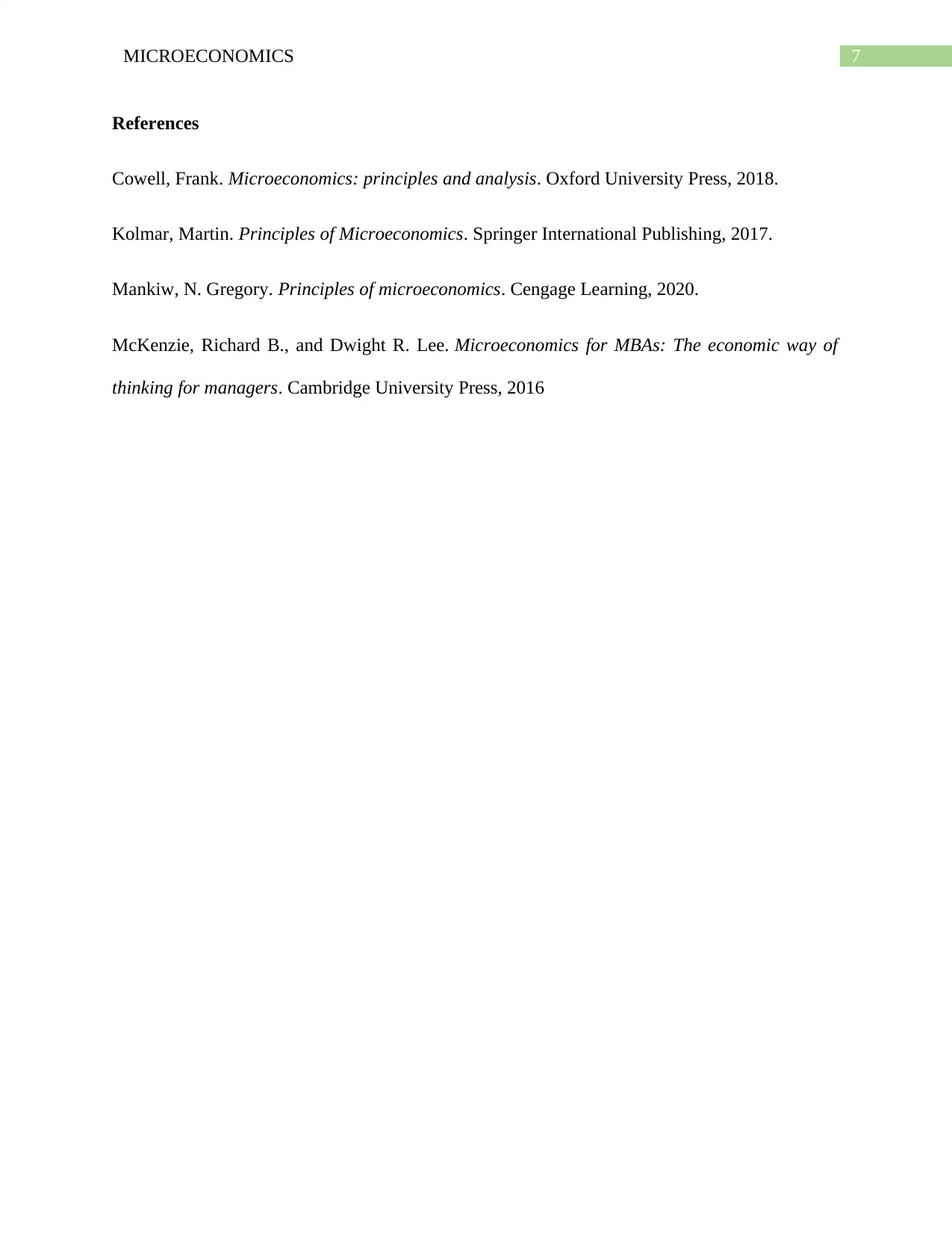
7MICROECONOMICS
References
Cowell, Frank. Microeconomics: principles and analysis. Oxford University Press, 2018.
Kolmar, Martin. Principles of Microeconomics. Springer International Publishing, 2017.
Mankiw, N. Gregory. Principles of microeconomics. Cengage Learning, 2020.
McKenzie, Richard B., and Dwight R. Lee. Microeconomics for MBAs: The economic way of
thinking for managers. Cambridge University Press, 2016
References
Cowell, Frank. Microeconomics: principles and analysis. Oxford University Press, 2018.
Kolmar, Martin. Principles of Microeconomics. Springer International Publishing, 2017.
Mankiw, N. Gregory. Principles of microeconomics. Cengage Learning, 2020.
McKenzie, Richard B., and Dwight R. Lee. Microeconomics for MBAs: The economic way of
thinking for managers. Cambridge University Press, 2016
1 out of 8
Related Documents
Your All-in-One AI-Powered Toolkit for Academic Success.
+13062052269
info@desklib.com
Available 24*7 on WhatsApp / Email
![[object Object]](/_next/static/media/star-bottom.7253800d.svg)
Unlock your academic potential
Copyright © 2020–2025 A2Z Services. All Rights Reserved. Developed and managed by ZUCOL.





